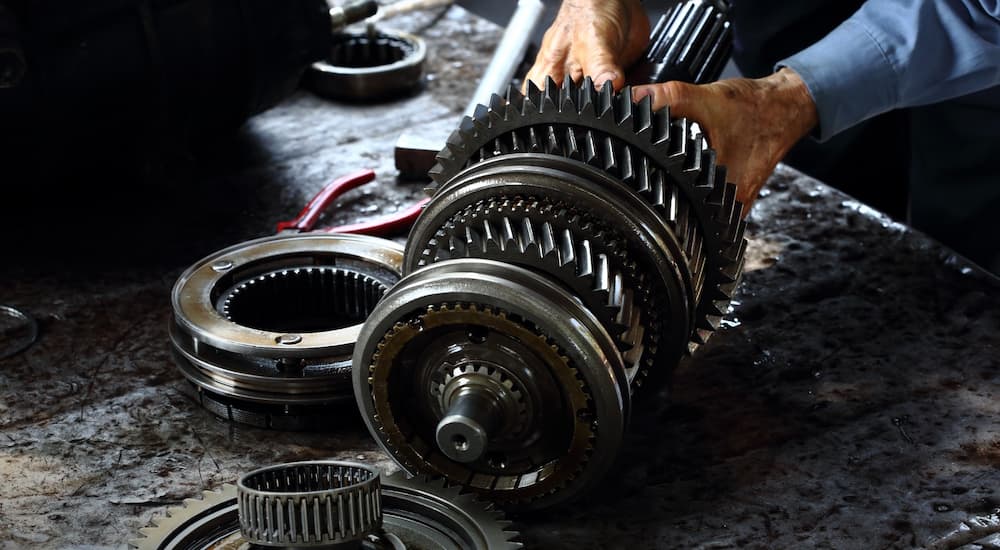A transmission, in the simplest terms, is what sends power from a vehicle’s engine to its wheels. Its job is to manipulate the ratio between engine speed and wheel speed so the car can drive optimally under different conditions. Sounds easy enough, but the transmission is actually one of the most intricate pieces of machinery found in a modern car. Transmission technology has come a long way, and today there are several different types of transmissions. They may all serve the same purpose, but how they get the job done varies, with each type putting its own spin (ha!) on the way driving a car feels.
Which transmission is best will depend on what you want as a driver. If you’re looking for used cars for sale and have a specific goal in mind for when you’re behind the wheel, picking the right transmission can be an important place to start. The type of transmission will factor into how expensive a car is, how fuel efficient it is, and how fun it is to drive. There are a lot of different kinds of transmissions, but I’m going to cover the four most common types: the manual transmission, automatic transmission, continuously variable transmission (CVT), and dual-clutch transmission (DCT).

Manual Transmission
Manual transmissions may be uncommon in modern cars, but they’re still loved by driving enthusiasts who enjoy the driver-to-vehicle connection they create. Instead of having the car automatically shift gears as needed, drivers have to monitor their speed and the tachometer to determine when it’s time to shift gears. By using the clutch pedal and gear shifter, drivers can select which gear the car is in.
A manual transmission can be loosely broken down into a few components: the flywheel is attached to the engine, and the clutch disc attaches to the flywheel and is controlled by the clutch pedal. After the clutch, it’s the gearbox and output shaft. When the driver presses the clutch pedal, the clutch disengages from the flywheel. The driver can then use the shifter to shift to the appropriate gear. Once that’s done, the driver can slowly let off the clutch pedal (slowly, so the flywheel and clutch can get closer to the same speed), and the connection between the engine and transmission resumes. Letting off the clutch too quickly will cause the vehicle to lurch forward or stall, which makes driving a manual smoothly something of an art that many people don’t want to deal with every day.
Automatic Transmission
Today, most cars have an automatic transmission. As technology advanced, automatic transmissions became more efficient and cheaper, leading to the manual’s eventual dethroning. They’re also very user-friendly, so cars with automatic transmissions can be driven by more people than manuals. Most automatic transmissions use hydraulic power to shift gears, and instead of a clutch, they have a torque converter.
The torque converter is what creates the connection between the engine and the transmission. Through the use of pressurized fluid, the torque converter can connect and disconnect the engine from the wheels while the car is changing gears or stopped, without the need to depress a clutch pedal. The gears of an automatic transmission tend to be different, too. They have a planetary structure, so it’s a set of gears, including one in the middle called the sun gear, housed in the circle of a ring gear. Using all of those gears grants more efficient access to the optimum level of torque needed at different speeds.
The “automatic” component of the automatic transmission is largely driven by the valve body. It’s a maze of channels that transmission fluid runs through, depending on how much is needed to shift to a certain gear. The valve body receives signals from the car’s ECU, based on factors like speed and air intake, to determine which gear the vehicle will operate the most efficiently in.
Continuously Variable Transmission
The continuously variable transmission, or CVT, is one of the most efficient transmissions on the market. It’s another type of automatic transmission but has one major difference from any other transmission. Instead of having gears, the CVT uses a pulley system to control the gear ratio.
A CVT has two pulleys––an input pulley and an output pulley––connected by a belt. The input pulley receives energy from the engine, and the output pulley sends that energy to the driveshaft. Each pulley is made of two cones pointing toward each other. The belt rides in the grooves between each pair of cones. As the cones move closer or farther apart, the belt will ride higher or lower in the groove. That action is what determines the gear ratio. Because the movement is a continuum rather than steps in a series of gears, there are an infinite number of gear ratios, and shifting between them is completely smooth.
Thanks to its simple and effective design, the CVT has proven efficient and reliable, making it increasingly popular in modern cars. They do, however, tend to strike out with driving enthusiasts. They feel different than automatic or manual transmissions, and their ultra-smooth gear shifting, although very efficient, inspires little to no thrills for the person behind the wheel. They also have a lower limit to how much torque they can safely handle, so you won’t find them in large trucks or SUVs.

Dual-Clutch Transmission
The dual-clutch transmission, often known as the DCT or PDK, resides on the premium end of transmissions (PDK stands for “Porsche Doppelkupplung” and was introduced by the iconic sports car brand). As the name implies. It’s a two-clutch system that has a knack for rapidly shifting between gears. One clutch controls the even gears, while the other controls the odds. It’s semi-automatic, and it borrows from both automatic and manual transmissions for unmatched performance.
We’ve already reviewed the manual transmission, so we know that when the clutch pedal is engaged, the power from the engine is no longer reaching the transmission. By using two clutches, the dual-clutch transmission avoids this interruption in power, alternating between gears seamlessly. They also don’t have a clutch pedal, instead using hydraulic power—like an automatic transmission—to drive the mechanics faster than a human driver would be capable of. Most production vehicles with this type of transmission will have a fully automatic mode where the car’s ECU does all the shifting for you, as well as a manual mode where the driver can select gears via paddle shifters or a stick shift.
The dual-clutch transmission is proof that man and machine can coexist in harmony, but the complexity of its design makes it expensive to manufacture and repair. This type of transmission is usually reserved for premium vehicles and sports cars, making them unattainable or unrealistic for a large percentage of drivers. However, there are some affordable used cars with dual-clutch transmissions, including several Hyundai, Kia, and Volkswagen models.
Transmissions: The Unsung Heroes
For being such a crucial part of the way our vehicles drive, transmissions seem to get far less attention than something like the engine or whether or not a car has leather seats. There may be nothing more critical to how driving a car actually feels than the type of transmission it has. Even if you don’t care much for driving, you probably care about how much fuel your vehicle uses or how smoothly it can accelerate up a hill. Well, the transmission type can factor into those things, too. The next time you’re shopping for a used car, take note of what kind of transmission it has and consider if that’s the best one for your needs. The right transmission may even be enough to get you excited to start your morning commute.

